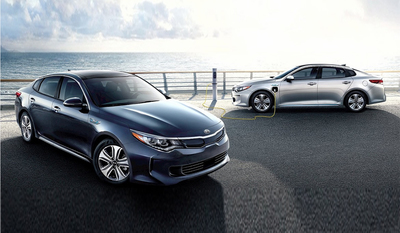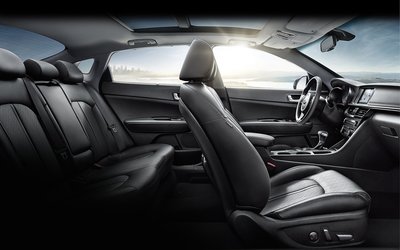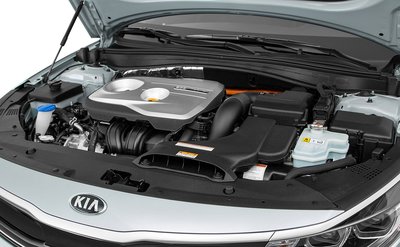2018 Kia Optima PHEV Review By Steve Purdy
2018 KIA OPTIMA PHEV
Review by Steve Purdy
The Auto Channel
Michigan Bureau
We’ve heard a few industry execs and a plethora of world leaders lately insisting the internal combustion engine is about to become shunned as the world dashes toward renewable and green energy. Evidence of that becoming ‘a thing’ is seen in the amount of energy and resources the world’s automakers are pouring into electrifying entire vehicle lines, regardless of minimal consumer acceptance and demand in today’s market.
Our flavor-of-the-week makes a big step in the direction of electrification of the everyday car. This mid-size, front-wheel drive 2018 Kia Optima mainstream sedan has a plug-in electric supplement to the small, efficient internal combustion, gasoline-fueled engine. Because it can run exclusively on the energy stored in its battery pack for 29 miles, and because you can plug it in to an electrical outlet to replenish the batteries, owners with short-distance driving needs can get by using very little, if any, fossil fuel. If their electricity comes from coal or natural gas power plant, another calculation might be in order.
The Optima PHEV (Plug-in Hybrid Electric Vehicle) looks just like its more conventional models except for revisions of the front fascia. Small cheek vents and LED DRLs add some more panache. Much of the grille is changed with the inclusion of active shutters and lots of blue-green trim surround the car as well. The Optima, I have contended for some time, is a handsome and modern design, if not particularly flashy.
Inside we find an up-to-date, fairly upscale design with good materials and excellent fit and finish. We would not mistake this interior for that of a luxury car but for a mainstream brand it has nothing for which to apologize. Controls and instrumentation remain simple, mostly conventional and easily managed, though a couple of the vehicle settings did not make themselves apparent as I tried to make some changes. I’ll wager your learning curve as you take charge of this car will be easier than most. Seats are comfortable front and rear with more rear room than you might expect. The batteries do not encroach on the interior volume, only on trunk space that holds a modest 9.9 cubic-feet of cargo.
Of course, the big story here is the super-efficient powertrain based on a smallish 2.0-liter four-cylinder with direct injection, good for just 154 horsepower, and a 67-horsepower electric motor (replacing the fly-wheel) fed by a 9.8 kWh lithium-polymer battery. The systems are remarkably well integrated with a sophisticated six-speed automatic transmission and together they provide a bit over 200 horsepower - plenty of performance, both in terms of power and efficiency. Kia says we can have about 29 miles on just electric power if we like. The EPA says we can expect about 40 mpg when relying on just the internal combustion engine with this 3,700-pound sedan. EPA’s complex calculation called MPGe (the “e” representing an attempt to standardize estimates of gallons used for a powertrain not using only liquid fuel) comes in at 103. Now, that number is not far off other plug-ins like Volt and Fusion. So, if you plug in regularly and don’t go over 29 miles between charges, you’ll not need gasoline at all.
Unlike some plug-ins the Optima can recharge itself while driving through regenerative braking and powertrain programming, though you’ll not normally get a big advantage unless you spend a lot of time in creepy crawly traffic. Of course, the congested urban environment is this car’s natural habitat. Those of us of a rural or suburban persuasion would see little benefit to this kind of car.
The sticker shows a base price for the Optima PHEV of $35,210, and it only comes in this well-equipped EX trim level. In addition to the powertrain enhancements, that price includes some premium content you’ll pay extra for on the lesser trim levels in the Optima line. The included stuff includes: 17-inch alloy wheels, dual-zone HVAC, navigation system with 8-inch touchscreen, Harman Kardon premium sound system, Kia’s UVO apps system with Apple CarPlay and Andriod Auto, integrated WiFi, leather seating and trim, heated front seats, push-button start, heated leather steering wheel, power everything and a full slate of safety features. Our test car has a $5,200 Technology Package that includes: power panoramic sunroof, LED headlights with dynamic light bending, ventilated front seats, heated rear seats, rear side window shades and all the driver-assistance extras like autonomous braking, smart cruise control, lane departure warning (not intervention) blind spot detection and forward collision warning. The bottom line on our sticker shows $41,355.
Ride and handling come down on the white bread side of the ledger. Again, in normal use we have nothing to complain about but it is not the kind of car you’ll want to push hard through the twisties. Conventional designed fully-independent suspension is tuned more toward comfort than crisp handling.
Kia’s warranty is one of the best in the industry covering the whole car for 5 years or 60,000 miles and the powertrain for 10 years or 100,000 miles.
The Kia Optima PHEV is a good choice for those wanting to make a statement about environmental cred, but only those who can live mostly within the full-electric driving range will see a big change in fuel usage. With fuel prices hovering in the $2.50 range and not expected to change much anytime soon, the chance of saving substantial costs is limited at best. It is, though, a pleasant, well-equipped, good-performing sedan you’ll find easy to live with.
© Steve Purdy, Shunpiker Productions, All Rights Reserved
The Most In-Depth Independent Kia Vehicle Shopper's Research - Anywhere!
- Kia Buyers Guide | Specs, Prices, Expert Reviews and Comparisons 2018-1997
- Find Your Perfect New Car Match
- Kia Reviews By The Auto Channel Journalists (1998-Present)
- The Auto Channel's Kia Brand Article Archives; News, Press Releases, Reviews, Specifications, Prices, Video, Images (76,999 Annotations)





